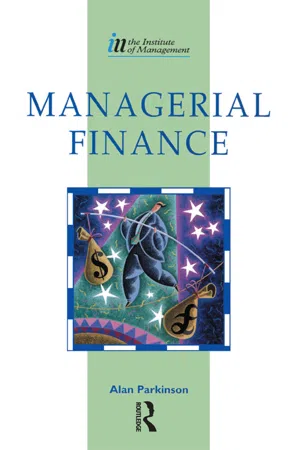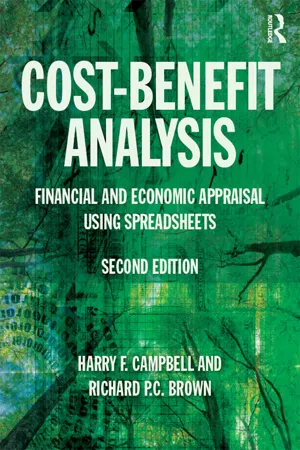Business
NPV Rule
The NPV (Net Present Value) rule is a financial concept used to evaluate the profitability of an investment. It compares the present value of expected cash inflows to the present value of cash outflows, taking into account the time value of money. If the NPV is positive, the investment is considered financially viable, while a negative NPV suggests the investment may not be worthwhile.
Written by Perlego with AI-assistance
Related key terms
Related key terms
1 of 4
Related key terms
1 of 3
12 Key excerpts on "NPV Rule"
- Daniel Adrian Doss, William H. Sumrall III, Don W. Jones(Authors)
- 2017(Publication Date)
- Routledge(Publisher)
Some initiatives may require periods that are longer than those that are considered within this text. When these situations occur, it is recommended that NPV calculations be performed through the use of software spreadsheets, proprietary software, or financial calculators. Also, within the context of collegiate finance courses, a tabular solution is also available to solve NPV problems involving a variety of periods. However, for the purposes of this text, the use of the basic formula is appropriate to demonstrate the basic concept of net present value and to delineate the calculations through which NPV problems are solved. Future editions of this text, if any, are anticipated to contain the tabular solution methods of NPV problems.6.8 Chapter Comments and Summary
This chapter introduced the net present value (NPV) method of capital budgeting. The methods of capital budgeting encompass perspectives of time, cash value, rate, and profitability potential. The NPV is indicative of a cash perspective regarding the rendering of capital budgeting decisions. Further, the NPV method incorporates the time value of money within its primary construct. Derivation of the NPV method can occur through algebraic manipulation of the current monetary value formula given in Chapter 4 .The NPV method involves a consideration of the anticipated cash flows of a capital investment through time. These anticipated future values are discounted to determine their current monetary equivalencies. Conceptually, the NPV is the sum of the present monetary value of the anticipated future cash flows of a potential capital investment excluding the costs of investment. Therefore, the NPV method provides a cash-based perspective regarding capital budgeting initiatives. The NPV may be used as a solitary method of capital budgeting or may be used in conjunction with any (or all) of the capital budgeting methods described within this text. The NPV method may be used to examine single capital initiatives or multiple capital initiatives. Further, this method may be used with or without the constraints imposed by mutual exclusion conditions.- eBook - ePub
- Brümmer LM, Hall JH, Du Toit E(Authors)
- 2017(Publication Date)
- Van Schaik Publishers(Publisher)
16310The capital investment decision
Learning outcomes
After studying this chapter, you should- understand the net present value method
- know how to calculate the net present value, for both a single sum and an annuity
- know how to apply the net present value method when purchasing shares
- know how to calculate the internal rate of return
- be able to apply the internal rate of return
- be able to apply the payback period method
- be able to make prudent decisions in the investment of capital.
Capital budgeting techniques
There is an extension or modification of the time value of money concept called the net present value, abbreviated to NPV. This is a sophisticated technique, providing a method whereby investment projects that yield cash inflows into the future may be valued in the present, which deals in net monetary amounts. This technique, together with two others, namely the internal rate of return and the payback period method, will be the focus of this chapter.Examples on the Statement of Financial Position that would involve application of the NPV method would be the organisation’s purchase of fixed assets and an investor’s purchase of shares in an organisation. We shall discuss these examples when we come to the detailed discussion on capital budgeting techniques later in this chapter.In the context of this book, an investment project will refer principally to the investment of funds in the purchase of fixed assets and shares. Since nobody can afford to invest money at a loss, the net present value method is a means of determining whether or not an investment will be a profitable proposition.A second technique, the internal rate of return (IRR), is also considered a sophisticated one and is indirectly related to the NPV. As the name implies, it is 164 intended to provide a rate of return - eBook - ePub
- R.A. Rayman(Author)
- 2013(Publication Date)
- Routledge(Publisher)
The internal rate of interest is that rate [if it exists] corresponding to which, the initial value of the investment account is equal to zero. … There may be no value which satisfies this equation. … On the other hand … there may be a multiplicity of solutions of this equation.(Samuelson, 1937 : 475)An ‘NPV decision rule’, which looks indistinguishable from the nineteenth-century original, has become firmly entrenched as part of the conventional wisdom. ‘It is now generally accepted that if capital markets are perfect, a firm acting in its shareholders’ interests should assess investments on the basis of their net present value’ (Edwards et al., 1987: 12). Even the method of calculation does not seem to have changed since the days of Böhm-Bawerk’s description of the declining present-value method of calculating depreciation (1888: 342–346). ‘The present value of an investment is given by discounting all the net cash flows it generates over its life at a rate given by the appropriate opportunity cost of capital’ (Edwards et al., 1987: 13).In the real world of risk and uncertainty, however, net cash flows cannot normally be forecast with absolute certainty; and, in imperfect markets where different investors have different preferences and access to different opportunities, ascertaining a single ‘appropriate opportunity cost of capital’ is not only practically difficult but also theoretically impossible.For purposes of demonstrating the validity of the ‘NPV decision rule’, however, it is normal to make the helpful assumptions that ‘the appropriate cost of capital is known’ and that ‘there is perfect certainty’ (Edwards et al., 1987: 14). Because these assumptions provide the most favourable conditions for the modern version, they are even more useful in demonstrating that the modern version is not valid even when the real-life problems are assumed away!The Flaw in the Modern Version of the ‘NPV Decision Rule'
The net cash flows associated with three different investment projects are shown in Table 10.1 - eBook - ePub
Finance for IT Decision Makers
A practical handbook
- Michael Blackstaff(Author)
- 2012(Publication Date)
- BCS, The Chartered Institute for IT(Publisher)
Finally, suppose that there is one other investment (Project B) under consideration besides ours (Project A), of roughly similar amount, size and risk to ours. Suppose also that the two investments are mutually exclusive, that is they are both competing for the same limited funds. As an IT example in real life, this situation might represent proposals for a required solution being tendered by different suppliers. Suppose Project B, when compared incrementally to ‘staying as we are’, yields a positive NPV of CU130k. If we are otherwise indifferent to which approach to adopt, then the numbers suggest that Project B should be undertaken rather than Project A (NPV CU75,180). This is because for a roughly similar investment it yields a higher positive NPV.Decisions are made by people, not by financial models. In making decisions, people take into account many things, including, but not limited to, the ‘advice’ suggested by financial models. Nevertheless, in IT decisions the financial numbers are often an important factor in the decision-making and may sometimes be decisive. Therefore, we need to be sure that we understand exactly what it is that a particular result is telling us. From what has just been discussed it is possible to formulate what we might call the ‘NPV decision rule’. It is as follows.THE NPV DECISION RULE If the estimated cash flows of an investment are discounted at the weighted average cost of capital, then:PROFITABILITY INDEX- if the resulting NPV is positive, by however small an amount, then the proposed investment is, in theory, worthwhile, because it would yield in real terms more than the money invested in it;
- if the resulting NPV is negative, by however small an amount, then the proposed investment is not worthwhile, because it would yield in real terms less than the money invested in it;
- if several mutually exclusive investments of similar kind, size and level of risk are competing for the same funds then the best option from a purely financial viewpoint is the one that yields the largest positive NPV.
Now suppose that we are evaluating two or more mutually exclusive projects of dissimilar size, exclusive either because of limited funds or because of the nature of the situation. An example would be the typical IT situation in which two or more suppliers are responding to a request to provide quotations for a particular IT solution. Suppose that ‘our’ project (Example 4.1), with its NPV of approximately CU75k, represents one such project, and that a competing one, when all of its estimated cash flows are taken into account, gives an expected NPV of CU80k. If all non-financial considerations between the two situations were regarded as equal, then which of the two should be accepted? The answer, at first glance, is the one that has the highest positive NPV. However, suppose that the initial investments required by the two alternatives, and their expected returns, were substantially different. Would it not be better to use a measure that indicated which project would generate most money from each CU spent? Such a ‘profitability index’ is sometimes used. The profitability index (PI) is usually taken as the total present value of the future net cash flows of a project (all the PVs except Year 0), divided by the present value of the net initial (Year 0) investment. - eBook - ePub
- P. Cassimatis(Author)
- 2013(Publication Date)
- Routledge(Publisher)
For example, a machine can be purchased today for $100,000. It has a useful life of 5 years and its cash flow is forecasted to be $30,000 per year. If the required rate of return is 10%, we haveThe required rate of return is the rate the firm can obtain from comparable investment alternatives. It is also known as the discount rate, the cost of capital, the hurdle rate, or the minimum acceptable rate of return.The advantages of the net present value method are that it takes into account the time value of money, and regardless of the pattern of cash flows, a single net present value is easily calculated. Consider, for example, the two investments shown below:Project A involves an initial investment of $2,500 and expected cash flows for 3 years. Project B requires the same initial investment, an additional cash outlay of $1,000 in the first year, and positive cash flows in the second and third year. Suppose the required rate of return is 10%. Then the NPVs of the projects are:Since the NPV of A is the larger of the two, project A is the better investment.When the cost of a project is spread over a number of years, the net present value of the investment is obtained as follows:Suppose, for example, a new assembly line is installed in a manufacturing plant and it takes one year to complete construction and another year to install the equipment. Cash flows, in thousand dollars, begin in the second year as shown in Figure 4.1 .The net present value of this project is computed as follows: Figure 4.1 Cash flows of project.4.2 Internal rate of return
Perhaps the method most widely used by engineers and business managers in evaluating capital projects is the internal rate of return method, commonly known as IRR. While this method has been criticized as having serious deficiencies, its major advantage is that it expresses the profitability of a capital investment in percentage terms, a measure that is easily understood by experts and laymen alike. The internal rate of return for an investment is the rate of return (i.e. interest rate) that makes the present value of the cash flows equal to the cost of the investment. Mathematically, it is calculated from - eBook - ePub
Making the Compelling Business Case
Decision-Making Techniques for Successful Business Growth
- W. Messner(Author)
- 2013(Publication Date)
- Palgrave Macmillan(Publisher)
It is now time to revisit the result of the calculation: the NPV is negative and thus the calculation uncovers a non-profitable investment proposition. But what would happen if the rate of return drops from 5 per cent to 3.5 per cent? Changing the value in cell E18 to 3.5 per cent throws out a positive NPV in cell E16 and the investment proposition begins to make sense again. Alternatively, if the owner of the real estate manages to rent it out at higher rates, this could for example increase the cash inflow in the first two years to $20,000 and to $25,000 in the third and fourth year. Now the calculation shows a positive NPV of $1,115.Spreadsheets like the one in Figure 2.6 help to experiment with the input data and thus facilitate a deeper understanding of an investment’s otherwise hidden dynamics. This kind of experimenting is commonly referred to as sensitivity analysis and Section 6.6 examines its possibilities in greater detail.Summary
The firm’s wealth maximization goal (see Section 1.1 ) states that financial management should endeavor to maximize the NPV of the expected future cash flows by taking two basic parameters into account2 :The longer it takes to receive a cash flow, the lower the value decision makers place on the cash flow today.The greater the risk associated with receiving a future cash flow, the lower the value decision makers place on that cash flow today.The wealth maximization goal thus reflects the magnitude, timing, and risk associated with cash flows expected to be received in the future as a result of investment decisions. It tells financial management what investments are to be preferred and how to make decisions.However, people often fail to understand the simple mathematical rationale of the time value of money, which is really the only principle behind calculating NPV. Instead, they perceive some other methods as methodically easier to understand, apply them instead, and in this process often mess up the correctness of the calculation. NPV is always (!) the most appropriate approach to calculating business cases; Sections 2.3 –2.6 describe the most common alternative methods, highlight their weaknesses (and strengths, if at all), and explain why they are always (!) inferior to the NPV method when making decisions on investment propositions. Sometimes they are indeed appropriate to use, but the same decision can always (!) be reached with the much more straightforward NPV method. Chapter 5 - Ivan E Brick(Author)
- 2017(Publication Date)
- WSPC(Publisher)
< 0.∑ is the Greek letter sigma. In mathematics it represents summation. The subscript letter t in CFt is a time index. The T = 1 below the sigma and N above the sigma implies that you are summing the present value of the cash flows from period 1 to n. Hence, the above equation is telling us to do the following mathematical operations:Fortunately, we can use the NPV function in excel to find the Net Present Value. Before, we do an example, let us give an economic interpretation for Equation (5.2) which is the second term of the right-hand side of Equation (5.1). In a nutshell, expression (5.2) represents the market value of the asset. For a given interest rate, it represents the maximum price you would pay for the asset. If the market value of the asset is greater than the initial investment, I, then you have yourself a great deal, the NPV is positive and you would accept the project. If you accept the project and the market believes in the firm’s projections, then the stock price should increase to reflect the positive NPV. On the other hand, if the market value of the asset is less than I, then the asking price is too high, NPV is negative and you would recommend rejection of the project. Should you accept the project, the stock price should fall!Interestingly, back in the 1980s, academic research found that whenever oil companies announced major exploration in the continental US, the stock price of that oil company declined at the time of the announcement. What was the stock market telling the managers of the firm? They were saying that given current oil prices and technology for oil extrapolation, these projects had a negative NPV.Let us do a more concrete example. As an assistant to Mr. Richard Wagoner, CEO of General Motors, you have been asked to analyze a potential new automobile model, Andromeda, and the staff has provided some key estimates. The amount of money GM will have to invest to launch the new brand is $450 million. The marketing staff estimates that the demand is fairly robust, projecting sales of 30,000 cars next year, 45,000 in the following 3 years, 30,000 in year 5 and no more sales thereafter. You estimate a profit of $5,000 per car sold. Mr. Frederick Henderson, Vice Chairman and Chief Financial Officer, tells you that GM’s cost of funds is 11%. You must make a presentation to both men in 20 minutes. What do you recommend? First thing is that you do not panic. Your job may depend on this presentation, but you still have your health.- eBook - ePub
- Keith Ward(Author)
- 2013(Publication Date)
- Routledge(Publisher)
However, money has a time value and if we are to make sensible decisions we need to incorporate the real value of future cash flows into our evaluation criteria. We can achieve this by applying discount rates to all future cash flows so that we bring them back to their equivalent present value, which makes all the project cash flows directly comparable. The most common way of doing this is to select a discount rate for the company and to apply this to all the cash flows of the project. A positive net present value indicates that the financial return from the investment is acceptable, but the opportunity costs evaluation against other potential investments must still be done. This requires comparison of what benefits could be achieved by investing in a different mix of projects and where there are constraints on the total amount of capital which can be invested, this comparison is very important. In such a situation of capital rationing, the profitability index can be used to compare relative investment returns between projects; this is done by dividing the present value of the net inflows by the value of the initial investment.Table 7.25 Comparison of internal rate of return (IRR) and accounting return on investmentSeveral major investment evaluation techniques are used by companies: 1 payback period; 2 discounted payback period; 3 Discounted cash flow (a) net present value (NPV) (b) internal rate of return (IRR); 4 Accounting return on investment (ARR).These provide different views of any project and no single criterion can be regarded as giving the answer, so many companies use a combination of techniques and adjust the results to allow for the relative risk of the investment being examined.AppendixNew car example using financial statements comparison ResuméOur sales and marketing director’s car cost £21 000 and is assumed to have a £6000 residual value at the end of three years. A fuel efficiency device becomes available for £4500 with projected savings of £2000 per year. - eBook - ePub
- Alan Parkinson(Author)
- 2012(Publication Date)
- Routledge(Publisher)
Table 7.2 can help to solve a dilemma. If a management team used an undiscounted cash flow assessment, both investments return the same net inflow of £170,000. The same applies to an undiscounted payback assessment with both investments paying back in 2.75 years. When the time value for money is considered however, a discounted NPV cash flow assessment, Investment B is favoured, returning £60,490 as opposed to £58,490 for A. On a discounted payback assessment however, Investment A pays back in 3.6 years, whereas B takes 4.4 years. Clearly, the dilemma facing the management team here is great. It is compounded by the fact that, on an IRR basis, A has a rate of 12.2% and B 11.4%.In ranking situations like this, where funds may be inadequate to finance all potentially profitable projects, or where a choice needs to be made between a number of contenders, a further method of evaluation called the profitability index could be used. This is based on the same data as the NPV method, in that a target rate of return has to be established and the NPV calculated. What then happens is that the present value of an investment’s inflows is related to the present value of its outflows in the form of a ratio, this being:Under this criterion, the two investments would be ranked as follows: The profitability index shows us the net present value of each £ invested. Under this criterion, investment B shows up better than A.It is quite common for the profitability index to be misused. This is because the term cash outflow is often interpreted as relating solely to the initial outlay at time 0. It is not unusual for net outflows to be encountered in subsequent years and these must be incorporated as outflows within the index calculation.In summary, what we can say is that the common aim of discounted cash flow techniques is to translate a projected stream of cash flows into one single index number that is then capable of comparison with other index numbers.If the projected net cash flows are discounted back to present values at a predetermined target rate of return, then the sum of these plus or minus discounted values will be the net present value of the project in absolute terms. If, on the other hand, they are discounted at a rate which results in the sum of the present values of the projected inflows equating exactly with the sum of the present values of the projected outflows, then the net present value will be nil and the rate that needs to be applied in order to achieve this balance is the internal rate of return of the project. This is consequently a relative - eBook - ePub
- Mark P. Holtzman, Sandy Hood(Authors)
- 2013(Publication Date)
- For Dummies(Publisher)
Table 11-16 ). The same project would now reduce the value of the business by £981.This analysis agrees with the news reports about interest rates. When the interest rate goes up, people are less likely to buy a house and firms tend to reduce their investments in new equipment and machinery. When interest rates go down, however, more people are willing to buy houses and more firms are prepared to borrow to invest.Figure 11-2 shows how the NPV falls as the discount rate rises.Figure 11-2: Net Present Value (NPV) and Internal Rate of Return (IRR).The point at which the line joining the different net present values crosses the zero net present value shows the discount rate where the net present value is zero. This is the IRR value: approximately 7.7 per cent.IRR takes into account the size of the investment, allowing you to compare different-sized projects alongside each other, and often a company’s Board of Directors is more familiar with percentage comparisons than with absolute cash values. But NPV has the advantage in showing how a project will affect the value of the business.In exams, the IRR can be found using a technique called interpolation. This approach involves identifying two different NPVs, ideally one that is positive and one that is negative.Here’s the formula: Using the Rum Financials example:Some students make errors in the calculation of the difference between the two NPVs. Remember that if one is a negative value and the other is a positive value, the difference is the gap between them. In other words, you can ignore the negative sign and add the two values together.In Rum Financials the fraction was 0.5654, and so the calculation is:5% + (0.5654 × 5%) = 7.83%This method is perfectly acceptable both at work and in exams. You may have noticed that we estimated 7.7 per cent from the diagram and found 7.83 per cent by calculation. Both values are fine. At work it is highly unlikely that a difference of 0.13 per cent would lead to accepting an investment project or not. All the figures are forecasts so precision is unlikely; we are merely recognising whether to invest. - eBook - ePub
Cost-Benefit Analysis
Financial And Economic Appraisal Using Spreadsheets
- Harry F. Campbell, Richard P.C. Brown(Authors)
- 2015(Publication Date)
- Routledge(Publisher)
Figure 2.1 . Both these approaches recognize the concept of “time value of money”, which means that dollars at different points of time cannot be directly compared.If the individual puts $AC in the bank this year, she will have the principal plus interest available to spend on consumption goods next year: this amounts to $AC(1 + r) where r is the annual rate of interest the money earns in the bank. If $AC(1 + r) < BC, then the return from the bank is less than that from the project and the individual will be made better off by choosing the project as compared with the bank. The condition for the project yielding a higher rate of return than that offered by the bank can be rewritten as BC/(1 + r) > AC, where BC/(1 + r) is the present value of the benefit of the project, AC is its opportunity cost, and r is the rate of interest paid by the bank. The present value is obtained by multiplying the project return, BC, by the discount factor 1/(1 + r), where r is the discount rate. In terms of Figure 2.1 , this is accomplished by projecting the length BC on to the vertical line through AC to get a point such as D, where DC is the present value; since DC = BC/(1 + r), it is apparent that the slope DC/BC equals the discount factor 1/(1 + r). The net present value (NPV) of the project is given by the present value of the project benefit, BC/(1 + r), less the project cost, AC. In mathematical terms both DC/BC and 1/(1 + r) in Figure 2.1 are negative values, but in this and subsequent discussion we talk in terms of absolute values; the purist can suppose that we have multiplied both sides of the slope equation by –1. The net present value is given by: BC/(1 + r) – AC, and is measured by the distance DA in Figure 2.1 .Figure 2.1Investment appraisal: an individual perspective. The individual’s income levels this year and next year, from sources other than the investment project, are given by Y0 and Y1 , represented by point A. The consumption level in the present year is Y0 if the project is not undertaken. The cost of the project is Y0 – C0 , where C0 represents the level of expenditure on consumption goods in year 0 (now) if the investment is undertaken (income of Y0 less savings of Y0 – C0 devoted to undertaking the investment); the cost of the investment is represented by the length AC. Undertaking the investment project provides a return which allows the individual to spend more on consumption goods next year than her income, Y1 , from other sources. Consumption next year in that event would be C1 and this means that the return on the investment is C1 – Y1 - eBook - ePub
Multiple Interest Rate Analysis
Theory and Applications
- M. Osborne(Author)
- 2014(Publication Date)
- Palgrave Pivot(Publisher)
et al . (2011) contains a classic statement of the arguments and lists four pitfalls.1 An IRR, by itself, does not indicate whether a project involves borrowing or lending;2 Some cash flows cause the IRR equation to solve for more than one plausible IRR, resulting in ambiguity about which IRR to use as a criterion;3 NPV and IRR do not always rank mutually exclusive projects the same; the consensus opinion is that ranking by NPV is reliable, and therefore ranking by IRR is not;4 A non-flat yield curve provides more than one cost of capital with which to compare IRR leading to uncertainty about which cost of capital to employ.Despite the pitfalls there is considerable empirical evidence that the majority of practitioners continue to use IRR as an investment criterion and performance measure. For example, in the context of capital budgeting there is the study of US data by Graham and Harvey (2001) and the similarly executed study of European data by Brounen et al . (2004). Many studies of capital budgeting practice are published every year containing similar results for various countries. In the context of IRR as a performance measure for private equity firms, hedge funds, and venture capitalists see the works by Phalippou (2008), Phalippou and Gottschalg (2009), Dichev and Yu (2011), and Achleitner et al.
Index pages curate the most relevant extracts from our library of academic textbooks. They’ve been created using an in-house natural language model (NLM), each adding context and meaning to key research topics.
Explore more topic indexes
Explore more topic indexes
1 of 6
Explore more topic indexes
1 of 4











